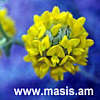 |
||||||||||||||||||||||||||||||||||
|
||||||||||||||||||||||||||||||||||
|
||||||||||||||||||||||||||||||||||
|
|||||||||||||||||||||||
 |
|||||||||||||||||||||||
| - | |||||||||||||||||||||||
|
||||
NORTH
The diversity is astounding. Every type of vegetation in Armenia inhabits the region, including small valleys that can grow the same plants as Meghri. Forests include Dry and Arax Oak, Eastern Beech, Caucasian Pine, a coniferous tree called the ‘Tis’, Elm, Tulip, Georgian Oak, evergreen and other deciduous tress. Marshlands and forests vie for attention with meadows teeming with wildflowers. All are inhabited by the largest diversity of animals in the country. The largest population of Royal Stag and deer are found in Tavush, along with kites, eagles, wild cats, bears, lynx and caucasian squirrels. The region is coursed by the Aghstev, Khndsorut, Tavush, Hakhum, Sarnajur, Spitakjur, Aksipara and Koghb Rivers, each of which feed the Kur River in Azerbaijan. The Aghstev River is the largest River in the region, with its headwaters in Lori Region. The rivers all run from South to North, dropping more than 2500 meters before they enter Azerbaijan. As such they form the greatest potential for hydroelectric generation in the country. Tavush District has the largest Nature Preserve in Armenia, the Dilijan Preserve. This technically prevents locals from logging the trees, but the energy blockade and a lack of adequate jobs in the region has meant this restriction is largely ignored. What is surprising when one visits the region is that while perhaps 5% of the forest has been logged since 1990, it is renewing itself in a relatively short period of time. Until substitute employment is created, though, the region is in danger of serious ecological damage. Lori District is known for its steep mountain passes, breathtakingly protecting mountain monasteries and medieval academies. Bordered by the Halab, Gugarats, Pambak and Bazum Mountain Ranges on the east, south and Southeast; and by the Lori Plateau on the North, Lori is as diverse and abundant as Tavush. Lori adds the contrasts of a complex alpine meadow and wet mountain steppe terrain in the West to complete its diversity. One of the greatest contrasts in Armenia comes from traveling by road from Vanadzor to Alaverdi or Stepanavan. From Vanadzor to Alaverdi, the road twists and turns through the Pambak and Debed River Canyons, which lie far below the peaks of the Gugarats Mountain Range. The weather system changes less than 10 kilometers outside of Vanadzor, supporting verdant green forests like those found in Tavush. Even in the height of summer, the hillsides and mountains in Lori are covered with green grass and wildflowers. Alaverdi lies in the same climactic zone as Meghri, and seldom receives more than a few weeks of freezing weather each year. Lori also lies on the edge of tectonic plates, but the Western plateau does not absorb tremors as well as the complex of plates in Tavush District. In 1988, near the town of Spitak, one of the most devastating earthquakes in Armenia occurred, killing 25,000 people in a wide swath of land between Giumri and the Gugarats Range. Spitak was leveled, as was much of Giumri and parts of Vanadzor. By taking the other road out of Vanadzor, to Stepanavan is an even more striking route. The road rises above Vanadzor through a gorge that is sparsely vegetated, lined with red and golden tuf, limestone and basalt. A tunnel passes through the Bazum Mountains to the other side, where a deciduous forest of mixed oaks, tis and elm covers the hills, while the Lori plateau stretches off in the distance. Rich loam supports an agricultural system that does not need irrigation. The rolling mountain meadow gradually gives way to mountains and mid-level forests near the Georgian border. Minerals, Stones, Gems Flora Mountain Flora include Tulipa florensvyi, T. confusa: f. pink, f. red, f. yellow, Iris grossheimii, I. Paradoxa, I. Caucasica, I. Pseudocaucasica, I. Atropatana, Mesendera candissima, Colchicum zangezurum, Hyacintella atropatana, Fritillaria kurdica, F. armena, Orchis simma, O. schelvcornikovii, O. stvenii, O. coriphora, Steveniella satyroides, Cephalanthera epipactoides, Epipactis latifolia, Acantholimon fedorovii, Reseda globulosa, Cercis griffithii, Gladiolus szovitsii, G. atroviolaceus, G. italicus, Punica granatum (wild), Tournefortia siberia, Calendula persica. Northern flora include Iris imbricata, Tulipa sosnovskyi, Fritillaria pinardii, F. armenia, Colchicum ninae, C. Szovitsii, Merendera raddeana, Crocus asamii, Corydalis persica, Ornithogalum sigmoideum, O. transcaucasicum, Genista transcaucasica, Mespilus germanica, Scilla mistscheukoana. River Gorge flora include Iris lineolata, I. Paradoxa, I. Caucasica, Allium stamineum, Bellevalia paradoxa, B. longystila, Muscari atropatana, M. sosnovskyi, Tulipa Sosnovskyi, Punica granatum, Vinca Vitis sylvestris, Ficus carica (wild). Sub-region flora include Alkanna orientalis, Cerasus incana, Prus, salicifolia, Cerasus mahaleb, Amygdalus ferzlinia, Spirala crenata, Saxifraga cymbalaria, Linaria armeniaca, Acantholimon bracteatum, Illium akana, Tulipa julia, Corydalis augustifolius, Orni-thogalum mountanum, O. gussonei, Campanula choziatorskyi, Bellevalia longystila, Muscari neglecta, Lotus goebelia, Astragalus strictifolius, Serratula serratuloides, Tomanthea aucheri, Malus oreientalis, Prunus divaricata, Sorbus graeca, S. persica, S. aucuparia, Crataegus orientalis, C. lacimiata. Other flora include Iris lineolata, I. Caucasia, Merendera mirzoeval, Colchicum szovitsii, Gagea ssp., Puschninia scilloides, Draba ssp., Lallemantia caneseens, Ranunculur ssp., Myosotis alpestris, Pedicularis ssp., Trifolium ssp., Gladiolus kotschyanus, Silene ssp. Birds Other Fauna Thermal and Mineral Springs
Climate
Change Info Center-Armenia
INDIVIDUAL REPORTS
|
| |
Search | |
||||||



![[Trees]"](storypage/storyimages/uploaded38autmuntrees.jpg)